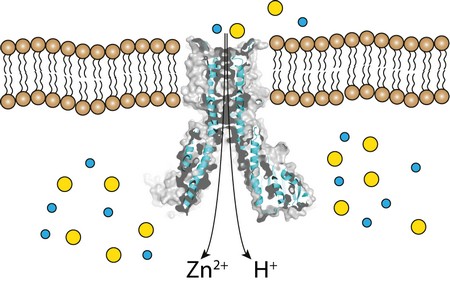Study shows active zinc uptake in bacteria
Researchers from the University of Groningen in collaboration with their colleagues from the MRC Laboratory of Molecular Biology have unravelled the structure of zinc specific bacterial transporter ZntB using cryo-electron microscopy, the technique, which was awarded the 2017 Nobel Prize for Chemistry. The results were published in Nature Communications on 3 November.

Every cell needs metals like zinc, cobalt or iron, but only in minute quantities, as they are toxic in higher concentrations. This means they need to tightly regulate the amount of metals and are equipped with transport systems and pores to import or export metals. It is of interest to understand the regulation of these metals in bacteria, as they might form a target to fight infections.
Important
Scientists from the Groningen Biomolecular Sciences and Biotechnology Institute (GBB), together with colleagues from the MRC Laboratory of Molecular Biology in Cambridge, UK, analysed the structure and function of ZntB, a protein involved in zinc transport in several kinds of bacteria.

This protein belongs to the wide-spread family of CorA proteins, which are important for the transport of magnesium across the membrane in the channel-like manner by forming a pore, which allows almost an instant flow of Mg2+ ions. However, the current study on ZntB revealed that the latter is not just a channel, but rather works as an active transporter. It imports zinc into the cells and this transport is coupled to the transport of protons.
Surprising
This was a surprising finding, as the structures of the CorA channel and the active ZntB transporter are very similar. The study therefore gives an excellent example of how the same protein fold have evolved for the transport of different cations using very different transport mechanisms
Reference: Cornelius Gati, Artem Stetsenko, Dirk J. Slotboom, Sjors H. W. Scheres & Albert Guskov, The structural basis of proton driven zinc transport by ZntB. Nature Communications, 3 November, DOI 10.1038/s41467-017-01483-7
| Last modified: | 07 November 2017 11.25 a.m. |
More news
-
10 June 2024
Swarming around a skyscraper
Every two weeks, UG Makers puts the spotlight on a researcher who has created something tangible, ranging from homemade measuring equipment for academic research to small or larger products that can change our daily lives. That is how UG...
-
21 May 2024
Results of 2024 University elections
The votes have been counted and the results of the University elections are in!

